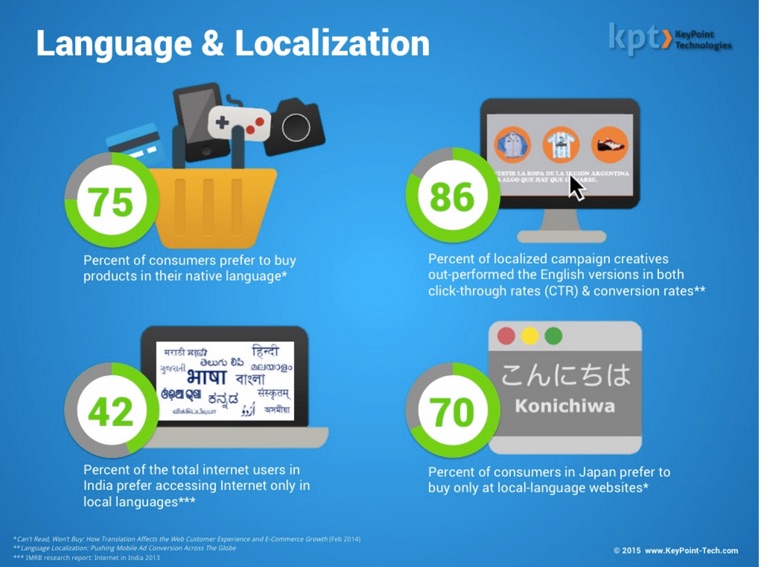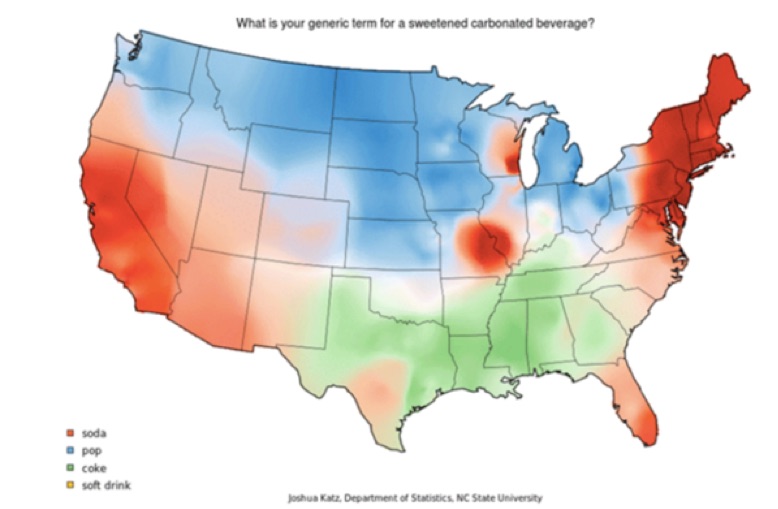It's all local.
Despite living in a global economy, many customers only care about what's happening in their neighborhoods and cities.
Brands must connect with consumers on their playing fields. And that means understanding people's languages, cultures, and traditions.
Marketing with location at the forefront offers some remarkable benefits. According to Nieman Journalism Lab, “geo-targeted [social media] posts were 6 times more successful than posts shared globally.”
“Localization goes beyond merely having to translate website content, and it connects with consumers on a personal level, builds your brand image in a way that is both accessible and unique. In short, localization is about building trust,” writes Danyelle C. Overbo, a Smartling contributor.
Let's explore how your ecommerce business can localize to boost sales.
Why Localize?
Localization enhances the consumer experience and expands your brand reach. It gives your business an opportunity to target a new consumer group.
Research shows that “75% of consumers prefer to buy products in their native language.”

But your team can't simply copy and paste marketing campaigns. Every region has its own culture-specific behaviors.
Be careful when entering into another market. Perform extensive research. That may involve localizing your taglines and slogans.
Nokia failed miserably when launching its Lumia phone in Spanish-speaking countries. The product name is slang for “prostitute” in Spanish. As a result, the brand received negative publicity.
“Even when dealing with industries or product categories that do not seem to need localization, there is a chance that a certain element of the marketing mix may need adaptation if the product(s) will be marketed internationally,” writes Dr. Nitish Singh, a cross-cultural digital media adviser.
And it's more than just delivering the right message. Sometimes, the distribution channel may be totally different.
“[I]f you are planning to use social media, you won't want to market Russian users on Facebook, but you would rather go for VKontakte, which ranks first among the top social network sites in Russia,” says Serena Pasqualetto, an ecommerce marketing specialist.
Let the corporate marketing team establish the overall tone of your brand. They are responsible for ensuring all markets recognize your logo and likeness. Your local marketing teams should lay the foundation to earn consumer trust in the communities.
This strategy is common in the smartphone business. Since 1 in 4 users purchase their devices based on stores in their area, companies increase local mobile ad spending to target these groups.
Localize your marketing. Make the right first impression to convert your target audience.
Work With Localization Specialists
Hire people who understand your consumers' language, culture, and behaviors. Local experts will know how to effectively sell to your customers.
“Who knows a given culture better than a local? Tap into local experts, whether in the form of staff, agencies, or in-country partners, from each of your target markets. This way your team can ensure the most accurate, localized experience for users,” says Amy Rigby, a freelance writer and world traveler.
Let's just be straightforward: don't use Google Translate.
If you're venturing into another country, don't rely on language translation tools to create your marketing materials. Their algorithms usually include errors and miss the context of the intended message.
For example, idioms don't translate well from country to country. In America, when it's raining heavily, one may say: it's raining cats and dogs.

We know animals aren't falling from the sky. But other cultures may be confused by this expression. So, avoid these types of phrases.
Unbounce hired Ben Harmanus to handle its German, Austrian and Swiss market (DACH). Their customers appreciated interacting with a local brand ambassador. He helped translate Unbounce's most popular content into the region's language.

Also, respect societal norms and create a cultural guide for each market. Explore beyond the general attitude of the area. Your team should analyze consumer behavior.
For instance, marketers in the United States use aggressive, sales-oriented campaigns. However, in Europe, your team may tone down the message.
More importantly, learn the laws of the area. Some regions prohibit words or phrases that are considered lewd.
Don't localize alone. Hire a specialist to get the job done right.
Diversify Your Product
Studies reveal that “65% of multinational enterprises believe localization is either important or very important for achieving higher company revenues.” Earning more sales might include changing your product.
Inc. contributor Susan Solovic writes, “Tweak your product or service so it appeals to a new group of consumers or users. If you have a 'high end' product or service, consider a less-expensive version. You need to be careful that you don't undercut yourself.”
Restaurant chains are very attentive to how they sell their products in other regions. Not only do they need to worry about the message, restaurants also must take local taste preferences into consideration.
For instance, Yum! Brands, the parent company of KFC, adapted its menu to Chinese customers. The brand offers East Dawning, a quick-service restaurant that provides authentic Chinese food served with tea.
How you package the product matters, too. Packaging often helps with brand identity and brand affinity.
Coca-Cola adapted its cans to attract Chinese buyers. This global beverage leader uses images of local celebrities and significant events to grab people's attention.

Use data to change your product line for different locations. Examine website traffic, pricing patterns, social media engagement, and regional consumer habits.
“VF Corporation combines third-party geodemographic and lifestyle data with daily store-level sales data, extensive consumer research, and competitor analysis to develop localization strategies with retailers, such as Kohl's.”
Facebook understands that localization means much more than just translating:
Founders, this is what localization means, not just translation. pic.twitter.com/cKubLTXYBa
- Arjun Sethi (@arjunsethi) January 14, 2016
Change your product to meet the needs of your consumer. Fit into their lifestyles.
Humanize Your Brand for Local Markets
No matter the location, your company is still marketing to humans. And people understand emotions.
“By positioning the brand behind a core mission to solve important human needs, then fulfilling on that mission with local sensitivity, brands can traverse cultural differences to provide their markets with truths that transcend language barriers,” states Chris Bolman, director of integrated marketing at Percolate.
Work with your team to develop campaigns that touch the hearts of your consumers. You must talk like the locals.
Even within America, vernacular is different from coast to coast. For example, what do you people in Minnesota call a sweetened carbonated beverage? Pop. But in Louisiana, residents normally say “coke.”

Imagery is another way to relate to the culture. Displaying photos that speak to a specific area gives customers a sense of comfort with your brand.
But be mindful of how you select your images.
Recently, North Carolina Senator Richard Burr received public backlash after showcasing his campaign ad. Instead of highlighting disadvantaged children in the state, his team used stock video of African children.

“One way to ensure that your photos are regionally relevant would be to only use photos taken by artists who live in said place,” states Janet Giesen, director of business development and APIs at Shutterstock.
“Localizing images will make you more familiar and relatable to your customers-they'll be more likely to recognize a bit of themselves (and the “human” aspects) in your brand.”
Sell to humans. Speak their dialect and highlight their culture.
Localize for Conversions
Every customer isn't experiencing life the same way. They see the world differently based on their location.
Learn how localization can benefit your brand. Hire local specialists to help your team navigate a different audience. And remember to humanize your brand.
Localize to convert.
About the Author: Shayla Price lives at the intersection of digital marketing, technology and social responsibility. Connect with her on Twitter @shaylaprice.
Walang komento:
Mag-post ng isang Komento